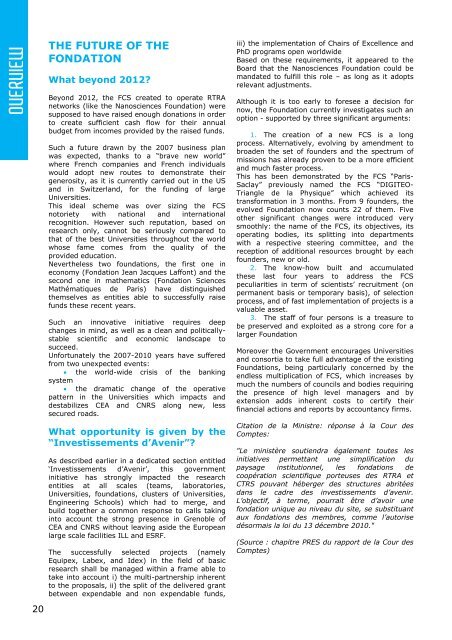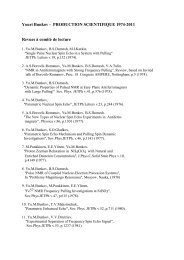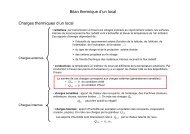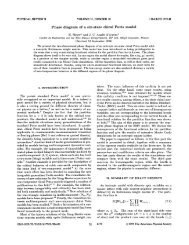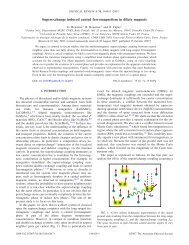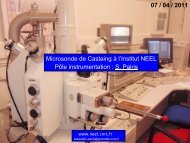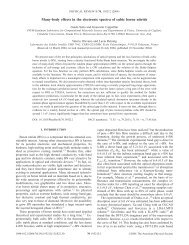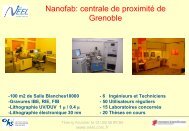Activity Report 2010 - CNRS
Activity Report 2010 - CNRS
Activity Report 2010 - CNRS
Create successful ePaper yourself
Turn your PDF publications into a flip-book with our unique Google optimized e-Paper software.
OVERVIEW<br />
20<br />
THE FUTURE OF THE<br />
FONDATION<br />
What beyond 2012?<br />
Beyond 2012, the FCS created to operate RTRA<br />
networks (like the Nanosciences Foundation) were<br />
supposed to have raised enough donations in order<br />
to create sufficient cash flow for their annual<br />
budget from incomes provided by the raised funds.<br />
Such a future drawn by the 2007 business plan<br />
was expected, thanks to a “brave new world”<br />
where French companies and French individuals<br />
would adopt new routes to demonstrate their<br />
generosity, as it is currently carried out in the US<br />
and in Switzerland, for the funding of large<br />
Universities.<br />
This ideal scheme was over sizing the FCS<br />
notoriety with national and international<br />
recognition. However such reputation, based on<br />
research only, cannot be seriously compared to<br />
that of the best Universities throughout the world<br />
whose fame comes from the quality of the<br />
provided education.<br />
Nevertheless two foundations, the first one in<br />
economy (Fondation Jean Jacques Laffont) and the<br />
second one in mathematics (Fondation Sciences<br />
Mathématiques de Paris) have distinguished<br />
themselves as entities able to successfully raise<br />
funds these recent years.<br />
Such an innovative initiative requires deep<br />
changes in mind, as well as a clean and politicallystable<br />
scientific and economic landscape to<br />
succeed.<br />
Unfortunately the 2007-<strong>2010</strong> years have suffered<br />
from two unexpected events:<br />
the world-wide crisis of the banking<br />
system<br />
the dramatic change of the operative<br />
pattern in the Universities which impacts and<br />
destabilizes CEA and <strong>CNRS</strong> along new, less<br />
secured roads.<br />
What opportunity is given by the<br />
“Investissements d’Avenir”?<br />
As described earlier in a dedicated section entitled<br />
‘Investissements d’Avenir’, this government<br />
initiative has strongly impacted the research<br />
entities at all scales (teams, laboratories,<br />
Universities, foundations, clusters of Universities,<br />
Engineering Schools) which had to merge, and<br />
build together a common response to calls taking<br />
into account the strong presence in Grenoble of<br />
CEA and <strong>CNRS</strong> without leaving aside the European<br />
large scale facilities ILL and ESRF.<br />
The successfully selected projects (namely<br />
Equipex, Labex, and Idex) in the field of basic<br />
research shall be managed within a frame able to<br />
take into account i) the multi-partnership inherent<br />
to the proposals, ii) the split of the delivered grant<br />
between expendable and non expendable funds,<br />
iii) the implementation of Chairs of Excellence and<br />
PhD programs open worldwide<br />
Based on these requirements, it appeared to the<br />
Board that the Nanosciences Foundation could be<br />
mandated to fulfill this role – as long as it adopts<br />
relevant adjustments.<br />
Although it is too early to foresee a decision for<br />
now, the Foundation currently investigates such an<br />
option - supported by three significant arguments:<br />
1. The creation of a new FCS is a long<br />
process. Alternatively, evolving by amendment to<br />
broaden the set of founders and the spectrum of<br />
missions has already proven to be a more efficient<br />
and much faster process.<br />
This has been demonstrated by the FCS “Paris-<br />
Saclay” previously named the FCS “DIGITEO-<br />
Triangle de la Physique” which achieved its<br />
transformation in 3 months. From 9 founders, the<br />
evolved Foundation now counts 22 of them. Five<br />
other significant changes were introduced very<br />
smoothly: the name of the FCS, its objectives, its<br />
operating bodies, its splitting into departments<br />
with a respective steering committee, and the<br />
reception of additional resources brought by each<br />
founders, new or old.<br />
2. The know-how built and accumulated<br />
these last four years to address the FCS<br />
peculiarities in term of scientists’ recruitment (on<br />
permanent basis or temporary basis), of selection<br />
process, and of fast implementation of projects is a<br />
valuable asset.<br />
3. The staff of four persons is a treasure to<br />
be preserved and exploited as a strong core for a<br />
larger Foundation<br />
Moreover the Government encourages Universities<br />
and consortia to take full advantage of the existing<br />
Foundations, being particularly concerned by the<br />
endless multiplication of FCS, which increases by<br />
much the numbers of councils and bodies requiring<br />
the presence of high level managers and by<br />
extension adds inherent costs to certify their<br />
financial actions and reports by accountancy firms.<br />
Citation de la Ministre: réponse<br />
Comptes:<br />
à la Cour des<br />
"Le ministère soutiendra également toutes les<br />
initiatives permettant une simplification du<br />
paysage institutionnel, les fondations de<br />
coopération scientifique porteuses des RTRA et<br />
CTRS pouvant héberger des structures abritées<br />
dans le cadre des investissements d’avenir.<br />
L’objectif, à terme, pourrait être d’avoir une<br />
fondation unique au niveau du site, se substituant<br />
aux fondations des membres, comme l’autorise<br />
désormais la loi du 13 décembre <strong>2010</strong>."<br />
(Source : chapitre PRES du rapport de la Cour des<br />
Comptes)


